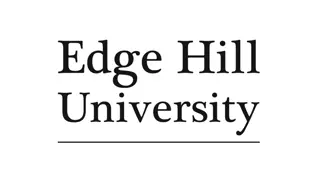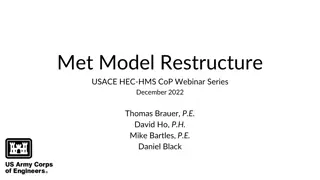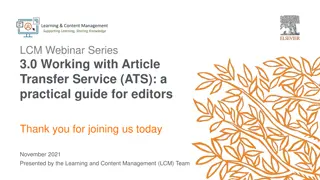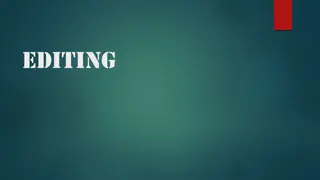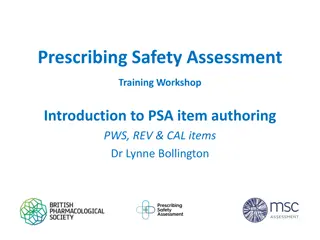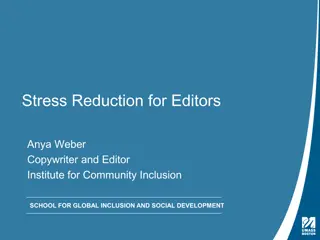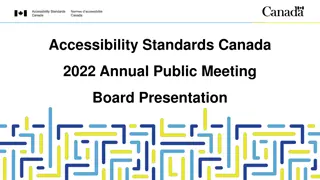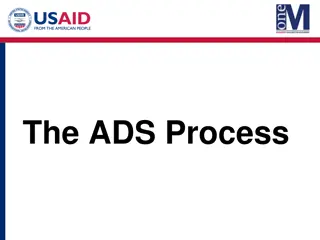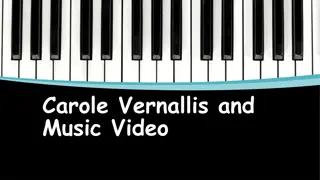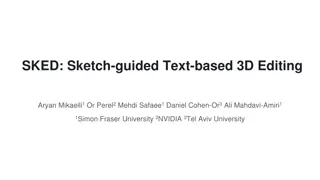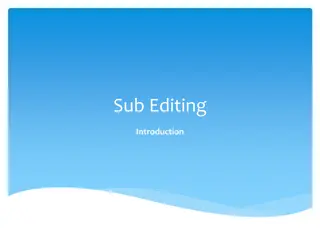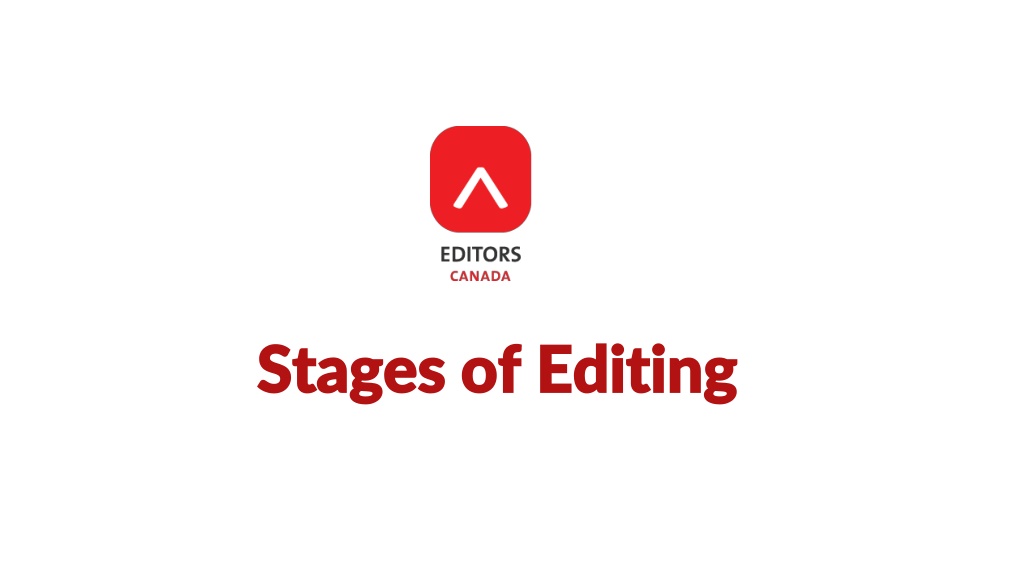
Effective Editing Techniques for Polishing Your Writing
Learn about the stages of editing, the goals of editing, different types of editing, and why following defined stages matter. Discover the importance of structural editing and stylistic editing in refining your content to meet audience needs and maintain consistency.
Download Presentation

Please find below an Image/Link to download the presentation.
The content on the website is provided AS IS for your information and personal use only. It may not be sold, licensed, or shared on other websites without obtaining consent from the author. Download presentation by click this link. If you encounter any issues during the download, it is possible that the publisher has removed the file from their server.
E N D
Presentation Transcript
Stages of Stages of Editing Editing
What is editing? Editing involves carefully reviewing material before it is published, and suggesting or making changes to correct or improve it.
What is the goal of editing? The goal of editing is to ensure that the material is consistent and correct its content, language, style, and design suit its purpose the text meets the needs of its audience
What stage of editing do you need? There are four stages of English editing: structural editing stylistic editing copy editing proofreading
Are these stages defined? Editors Canada defines each of these stages of editing and there are editorial standards that go with them. The definitions were updated in 2019. www.editors.ca/hire/definitions.html
Why does it matter? Does it matter if you call it editing and I call it proofreading? Using the same definitions and standards is good for business: It saves time. It saves money. It helps ensure that everyone on a project agrees about what work is being done.
Structural editing Assessing and shaping draft material to improve its organization and content. Changes may be suggested to or drafted for the writer. May include revising, reordering, cutting, or expanding material writing original material determining whether permissions are necessary for third- party material recasting material that would be better presented in another form, or revising material for a different medium (such as revising print copy for web copy) clarifying plot, characterization, or thematic elements
Stylistic editing Editing to clarify meaning, ensure coherence and flow, and refine the language. It includes eliminating jargon, clich s, and euphemisms establishing or maintaining the language level appropriate for the intended audience, medium, and purpose adjusting the length and structure of sentences and paragraphs establishing or maintaining tone, mood, style, and authorial voice or level of formality
Copy editing (1) Editing to ensure correctness, accuracy, consistency, and completeness. It includes: editing for grammar, spelling, punctuation, and usage checking for consistency and continuity of mechanics and facts editing tables, figures, and lists notifying designers of any unusual production requirements developing a style sheet or following one that is provided correcting or querying general information that should be checked for accuracy
Copy editing (2) Copy editing may also include marking levels of headings and the approximate placement of art Canadianizing or other localizing converting measurements providing or changing the system of citations editing indexes obtaining or listing permissions needed checking front matter, back matter, and cover copy checking web links
Proofreading (1) Examining material after layout or in its final format to correct errors in textual and visual elements. The material may be read in isolation or against a previous version. It includes checking for adherence to design minor mechanical errors (such as spelling mistakes or deviations from style sheet) consistency and accuracy of elements in the material (such as cross-references, running heads, captions, web page heading tags, hyperlinks, and metadata)
Proofreading (2) It may also include distinguishing between printer's, designer's, or programmer's errors and writer's or editor's alterations copyfitting flagging or checking locations of art inserting page numbers or checking them against content and page references Note that proofreading is checking a work after editing; it is not a substitute for editing.
Other editorial tasks Other editorial tasks can include the following acquisitions editing comparative editing electronic coding or tagging fact checking formatting indexing manuscript evaluation production editing rewriting visual research web editing Find descriptions here: www.editors.ca/hire/definitions-editorial-skills
What are the Professional Editorial Standards? Professional Editorial Standards are the knowledge, skills, and practices most commonly required for editing English-language material. The standards are statements about levels of performance that editors aspire to achieve.
What are the Professional Editorial Standards? They clarify what is expected of Canadian editors and define the criteria against which their knowledge, skills, and practice can be measured. Editors who meet these standards are able to do a professional job with minimum supervision.
Who can use the standards: editors Editors use the standards to better understand the range of skills and knowledge they should aspire to support their own continuing education and professional development explain what editing is and what editors do define best practices for doing their work
Who can use the standards: employers Employers can use the standards to know what to expect from the editors they hire develop job descriptions create performance evaluation tools
How long will an edit take? That depends on several things, including the type of document the length of the document the stage of edit needed your deadline the audience the medium (print or electronic) how many other items the editor has in the queue your document won t be the only one the editor has to work on
Guidelines for estimating time needed for an English edit Type of edit Pages per hour (a page is 250 words) light copy edit 6 8 pages per hour stylistic edit or heavy copy edit 3 4 pages per hour substantive edit depending on the text typical: 2 3 pages per hour sometimes: 1 1.5 pages per hour Note: many editors will do a second or even a third pass through a document to proofread it or catch issues they missed the first time.
What Editors Canada does What Editors Canada does promotes professional editing as key in producing effective communication supports professional development for editors promotes and maintains high standards of editing through certification and reference publications helps in-house and freelance editors to network and collaborate cooperates and partners with related associations in areas of common concern
About Editors Canada About Editors Canada Editors Canada/R viseurs Canada is a not-for-profit association. It has about 1300 members (English and French), in branches and smaller groups (called twigs) across the country. Its national office and staff are in Toronto. It is governed by a board of directors (the national executive council), composed of members from across Canada. Its members volunteer on national committees.
Publications and resources Publications and resources Editing Canadian English, 3rd edition Editorial Niches Guidelines for Ethical Editing of Theses / Dissertations Professional Editorial Standards Meeting Professional Editorial Standards Certification study guides Standard Freelance Editorial Agreement and more! Editorial Niches <em>Editing Canadian English</em>, 3rd edition Professional Editorial Standards 2016
Connect with Editors Canada online Connect with Editors Canada online Editors.ca | Reviseurs.ca info@editors.ca Facebook @Editors/R viseurs Canada Twitter @editorscanada Twitter chats #EditorsChat LinkedIn The Editors Weekly blog





